Chapter 9 Control and Co-ordination
1. Multiple choice questions
Question 1.
The nervous system of mammals uses both electrical and chemical means to send signals via neurons. Which part of the neuron receives impulse?
(a) Axon
(b) Dendron
(c) Nodes of Ranvier
(d) Neurilemma
Answer:
(b) Dendron
Question 2.
……………. is a neurotransmitter.
(a) ADH
(b) Acetyl CoA
(c) Acetyl choline
(d) Inositol
Answer:
(c) Acetyl choline
Question 3.
The supporting cells that produce myelin sheath in the PNS are …………….
(a) Oligodendrocytes
(b) Satellite cells
(c) Astrocytes
(d) Schwann cells
Answer:
(d) Schwann cells
Question 4.
A collection of neuron cell bodies located outside the CNS is called …………….
(a) tract
(b) nucleus
(c) nerve
(d) ganglion
Answer:
(d) ganglion
Question 5.
Receptors for protein hormones are located …………….
(a) in cytoplasm
(b) on cell surface
(c) in nucleus
(d) on Golgi complex
Answer:
(b) on cell surface
Question 6.
If parathyroid gland of man Eire removed, the specific result will be …………….
(a) onset of aging
(b) disturbance of Ca++
(c) onset of myxoedema
(d) elevation of blood pressure
Answer:
(b) disturbance of Ca++
Question 7.
Hormone thyroxine, adrenaline and non¬adrenaline are formed from ……………
(a) Glycine
(b) Arginine
(c) Ornithine
(d) Tyrosine
Answer:
(d) Tyrosine
Question 8.
Pheromones are chemical messengers produced by animals and released outside the body. The odour of these substance affects …………….
(a) skin colour
(b) excretion
(c) digestion
(d) behaviour
Answer:
(d) behaviour
Question 9.
Which one of the following is a set of discrete endocrine gland?
(a) Salivary glands, thyroid, adrenal, ovary
(b) Adrenal, testis, ovary, liver
(c) Pituitary, thyroid, adrenal, thymus
(d) Pituitary, pancreas, adrenal, thymus
Answer:
(c) Pituitary, thyroid, adrenal, thymus
Question 10.
After ovulation, Graafian follicle changes into …………….
(a) corpus luteum
(b) corpus albicans
(c) corpus spongiosum
(d) corpus callosum
Answer:
(a) corpus luteum
Question 11.
Which one of the following pairs correctly matches a hormone with a disease resulting from its deficiency?
(a) Parathyroid hormone – Diabetes insipidus
(b) Luteinising hormone – Diabetes mellitus
(c) Insulin – Hyperglycaemia
(d) Thyroxine – Tetany
Answer:
(c) Insulin – Hyperglycaemia
Question 12.
……………. is in direct contact of brain in humans.
(a) Cranium
(b) Dura mater
(c) Arachnoid
(d) Pia mater
Answer:
(d) Pia mater
2. Very very short answer questions.
Question 1.
What is the function of red nucleus?
Answer:
Red nucleus plays an important role in controlling posture and muscle tone, modifying some motor activities and motor coordination.
Question 2.
What is the importance of corpora quadrigemina?
Answer:
Corpora quadrigemina consists of 4 solid rounded structures, viz. superior and inferior colliculi. Superior colliculi control visual reflexes while inferior colliculi control auditory reflexes.
Question 3.
What does the cerebellum of brain control?
Answer:
Cerebellum of brain is an important centre which maintains equilibrium of body, posture, balancing orientation, moderation of voluntary movements and maintenance of muscle tone.
Question 4.
Name the three ear ossicles.
Answer:
Malleus [hammer], incus [anvil] and stapes [stirrup].
Question 5.
Name the anti abortion hormone.
Answer:
Progesterone.
Question 6.
Name an organ which acts as temporary endocrine gland.
Answer:
Placenta. Corpus luteum in ovary.
Question 7.
Name the type of hormones which bind to the DNA and alter the gene expression.
Answer:
Steroid hormones.
Question 8.
What is the cause of abnormal elongation of long bones of arms and legs and of lower jaw.
Answer:
Hypersecretion of growth hormones in adults causes abnormal elongation of long bones of arms and legs and of lower jaw i.e. acromegaly.
Question 9.
Name the hormone secreted by the pineal gland.
Answer:
Melatonin.
Question 10.
Which endocrine gland plays important, role in improving immunity?
Answer:
The endocrine gland, thymus plays an important role in improving immunity.
3. Match the organism with the type of nervous system found in them.
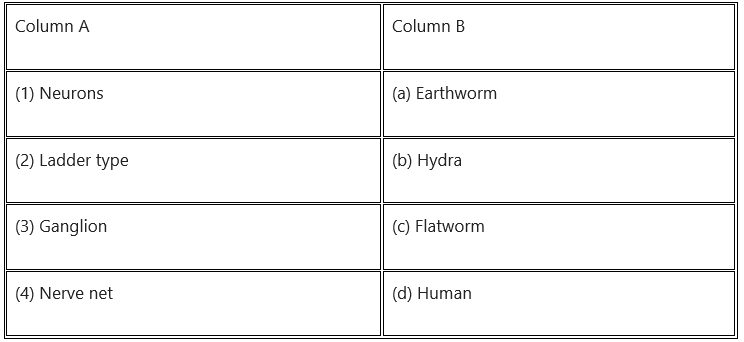
Answer:
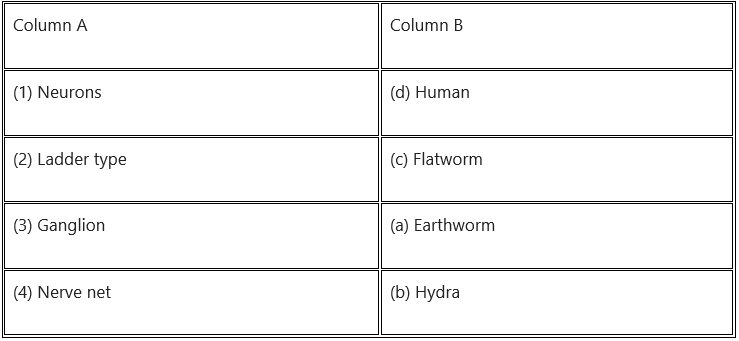
4. Very short answer questions.
Question 1.
Describe the endocrine role of islets of Langerhans.
OR
Islets of Langerhans.
Answer:
Endocrine cells of pancreas form groups of cells called Islets of Langerhans. There are four kinds of cells in islets of Langerhans which secrete hormones.
- Alpha (α) cells : They are 20% and secrete glucagon. Glucagon is a hyperglycemic hormone. It stimulates liver for glucogenolysis and increases the blood glucose level.
- Beta (β) cells : They are 70% and secrete insulin. Insulin is a hypoglycemic hormone. It stimulates liver and muscles for glycogenesis. This lowers blood glucose level.
- Delta (δ) cells : They are 5% and secrete somatostatin. Somatostatin inhibits the secretion of glucagon and insulin. It also decreases the gastric secretions, motility and absorption in digestive tract. In general it is a growth inhibiting factor.
- PP cells or F cells : They form 5%. They secrete pancreatic polypeptide (PP) which inhibits the release of pancreatic juice.
Question 2.
Mention the function of testosterone?
Answer:
Testosterone is a steroid sex hormone secreted by testes and cortex of adrenal glands. It controls the secondary sexual characters in males.
Question 3.
Give symptoms of the disease caused by hyposecretion of ADH.
Answer:
Polydipsia, i.e. frequent thirst and polyuria, i.e. frequent urination are the symptoms of the disease caused by hyposecretion of ADH.
5. Short answer questions
Question 1.
Rakesh got hurt on his head when he fell down from his motorbike. Which inner membranes must have protected his brain? What other roles do they have to play
Answer:
- When Rakesh fell down from his motorbike, the inner membranes that protected his brain were meninges, viz. dura mater, arachnoid membrane and pia mater. Morevover, CSF must have also acted as a shock absorber.
- Dura mater : It is the outer tough membrane protective in function.
- Arachnoid membrane : It is the middle web-like membrane which communicates with fluids of upper sub dural space and lower sub arachnoid space.
- Pia mater : It is the innermost highly vascularised nutritive membrane in close contact with brain and spinal cord.
Question 2.
Injury to medulla oblongata may prove fatal.
OR
Injury to medulla oblongata causes sudden death. Explain.
Answer:
- Medulla oblongata is the region of the brain that controls all the involuntary activities.
- Vital activities such as heartbeats, respiration, vasomotor activities, peristalsis, etc. are under the control of medulla oblongata.
- When medulla oblongata is injured, all these vital functions are instantly stopped.
- Therefore, injury to medulla oblongata causes sudden death.
Question 3.
Distinguish between the sympathetic and parasympathetic nervous system on the basis of the effect they have on:
Heartbeat andUrinary Bladder.
Answer:

Question 4.
While holding a tea cup Mr. Kothari’s hands rattle. Which disorder he may be suffering from and what is the reason for this?
Answer:
- This condition is due to Parkinson’s disease.
- It is due to degeneration of dopamine- producing neurons in the CNS.
- 80% of the patients develop this condition along with stiffness, difficulty in walking, balance and coordination.
Question 5.
List the properties of the nerve fibres.
Answer:
- Excitability / irritability
- Conductivity
- Stimulus
- Summation
- All or none
- Refractory period
- Synaptic delay
- Synaptic fatigue
- Velocity.
Question 6.
How does tongue detect the sensation of taste?
Answer:
- The surface of tongue is with gustatoreceptors.
- These receptors are sensitive to the chemicals [sweet, salt, sour, bitter and umami (savory)] present in the food.
- The receptor cells get stimulated, generate the impulse which is given to the sensory neuron.
Question 7.
State the site of production and function of Secretin, Gastrin and Cholecystokinin.
Answer:
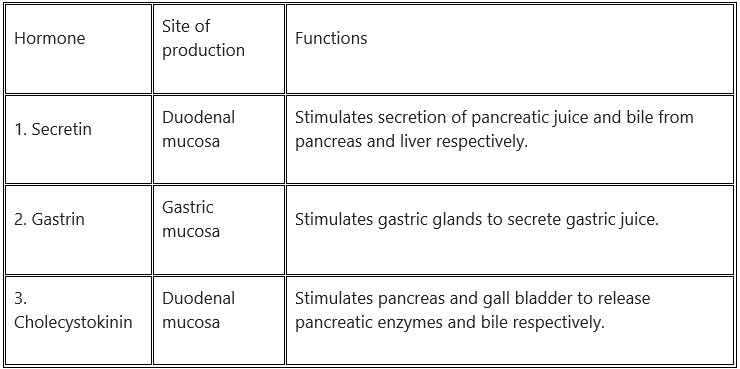
Question 8.
An adult patient suffers from low heart rate, low metabolic rate and low body temperature. He also lacks alertness, intelligence and initiative. What can be this disease? What can be its cause and cure ?
Answer:
- The above symptoms indicate that the person is suffering from Myxoedema.
- Myxoedema is condition caused due to hypothyroidism.
- Hypothyroidism causes deficiency of thyroid hormones like T3 and T4 (thyroxine). This results in low BMR.
- This condition can be cured by giving injections of thyroxine or tablets containing hormone preparation.
Question 9.
Where is the pituitary gland located? Enlist the hormones secreted by anterior pituitary.
Answer:
The pituitary gland is attached to hypothalamus on the ventral surface of brain. It is lodged in a bony depression called sella turcica of sphenoid bone.
For names of hormones:
- GH : [Growth Hormone/STH : Somatotropic Hormone]
- TSH/TTH – [Thyroid Stimulating Hormone/ Thyrotropic Hormone]
- ACTH – [adrenocorticotropic hormone]
- PRL – [prolactin]
Gonadotropins-
- FSH [follicle stimulating hormone]
- LH/ICSH – [leutinizing hormone/ interstitial cells stimulating hormone]
Question 10.
Explain how the adrenal medulla and sympathetic nervous system function as a closely integrated system.
Answer:
- Adrenal medulla originates from embryonic neuro – ectoderm.
- It consists of rounded group of large granular cells called chromaffin cells. They are modified post-ganglionic cells of sympathetic nervous system which have lost normal processes and acquired glandular function.
- These cells are connected with pre-ganglionic fibres of sympathetic nervous system.
- Hence adrenal medulla is an extension of sympathetic nervous system.
- Thus adrenal medulla and sympathetic nervous system functions as a closely integrated system.
Question 11.
Name the secretion of alpha, beta and delta cells of islets of Langerhans. Explain their role.
Answer:
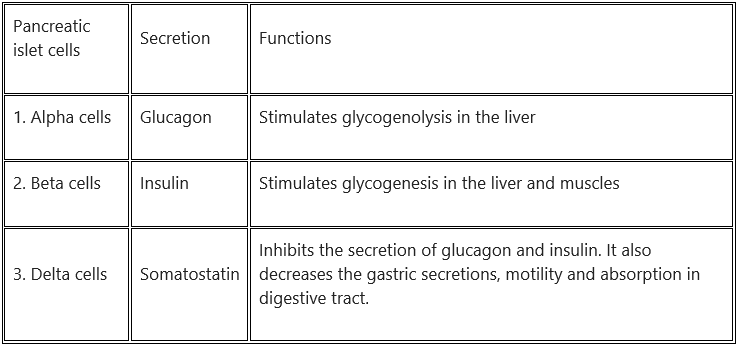
Question 12.
Which are the two types of goitre? What are their causes?
Answer:
(1) Goitre is the enlargement of thyroid gland. It is easily visible at the base of neck when a person is suffering from it.
(2) Goitre is of two types.
- Simple goitre : It is also called endemic goitre. This is due to iodine deficiency in the food. This causes iodine deficit in blood. In an attempt to take more iodine from blood, the blood supply to the gland increases. This results in swelling on the thyroid.
- Exophthalmic goitre : It is also called toxic goitre. This is due to hyperactive thyroid gland. This can happen if there is overstimulation of thyroid due to excess of ACTH. This disorder is also called Grave’s disease or hyperthyroidism.
Question 13.
Name the ovarian hormone and give their functions.
Answer:
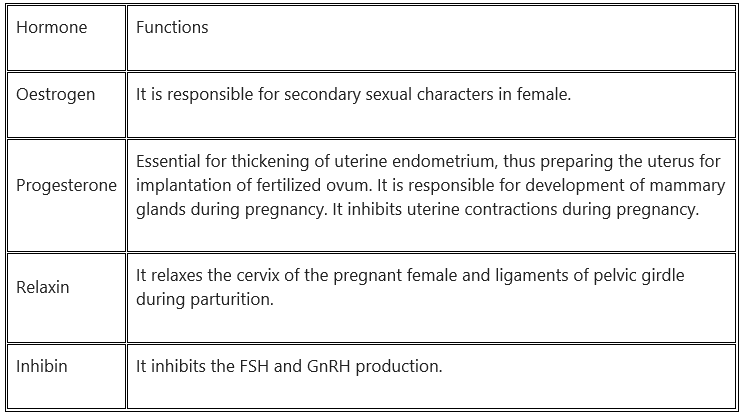
6. Answer the following.
Complete the table.
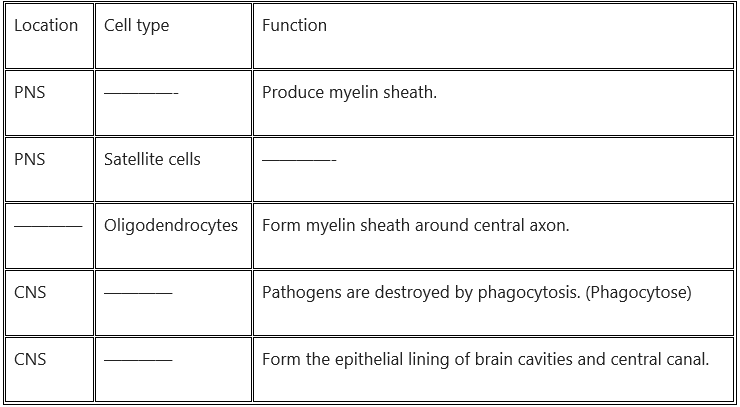
Answer:
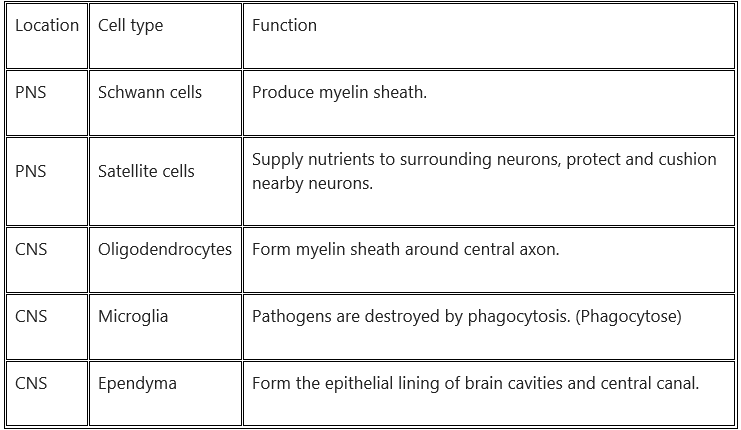
7. Long answer questions.
Question 1.
Explain the process of conduction of nerve impulses up to development of action potential.
Answer:
- The origin and maintenance of resting potential depends on the original state of no stimulation.
- Any stimulus or disturbance to the membrane will make the membrane permeable to Na+ ions. This causes rapid influx of Na+ ions.
- The voltage gated Na+/K+ channels are unique. They can change the potential difference of the membrane as per the stimulus received and also the gates operate separately and are self closing.
- During resting potential, both gates are closed and resting potential is maintained.
- However during depolarization, the Na+ channels open but not the K+ channels. This causes Na+ to rush into the axon and bring about a depolarisation. This condition is called action potential.
- Extra cellular fluid (ECF) becomes electronegative with respect to the inner membrane which becomes electropositive.
Question 2.
Draw the neat labelled diagrams.
a. Human ear.
Answer: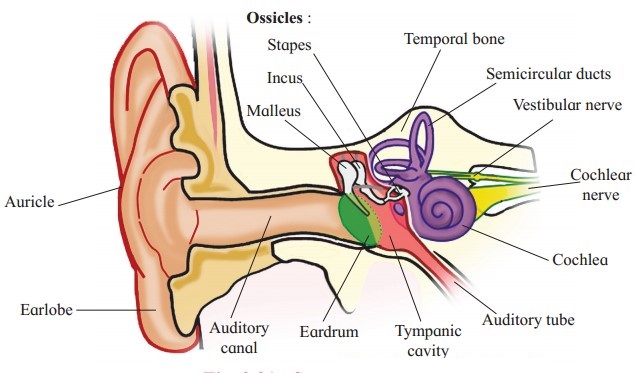
b. Sectional view of human eye.
Answer: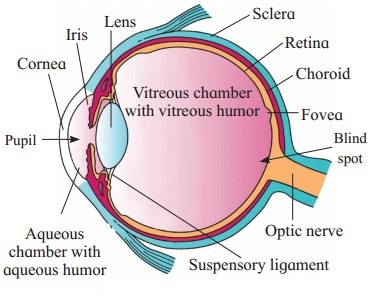
c. Draw the neat labelled diagram of sagittal section or L.S. of human brain
Answer: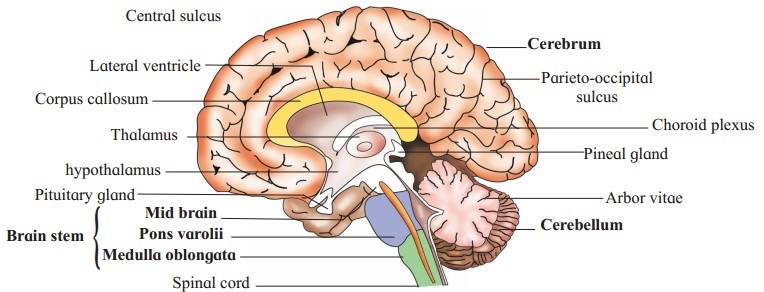
d. Draw the neat labelled diagram of Multipolar Neuron.
Answer: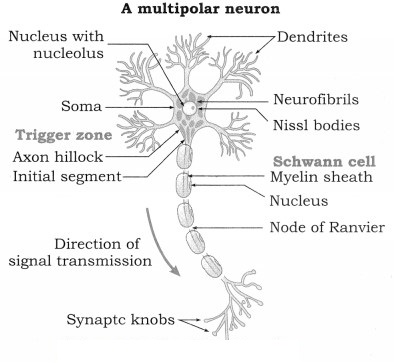
Question 3.
Answer the questions after observing the diagram given below.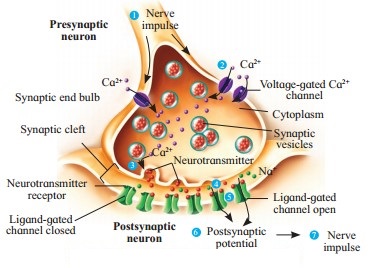
a. What do the synaptic vesicles contain?
Answer:
Synaptic vesicles contain a neurotransmitter – acetyl choline.
b. What process is used to release the neurotransmitter ?
Answer:
Exocytosis.
c. What should be the reason for the next impulse to be conducted?
Answer:
Removal of neurotransmitter by the action of acetyl cholinesterase.
d. Will the impulse be carried by post synaptic membrane even if one pre-synaptic neuron is there?
Answer:
As far as impulse is transmitted by pre-synaptic neuron, it will be received by post-synaptic neuron.
e. Can you name the channel responsible for their transmission?
Answer:
Ca++ channel
Question 4.
Explain the Reflex Pathway with the help of a neat labelled diagram.
OR
With the help of a neat and labelled diagram, describe reflex arc.
Answer:
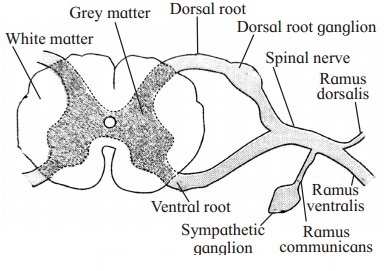
I. Reflex action : Reflex action Is defined as a quick, automatic involuntary and often unconscious action brought about when the receptors are stimulated by external or internal stimuli.
II. Reflex arc : Reflex actions are controlled by CNS. Reflex arc is the structural or functional unit of reflex action. Simple reflex arc is formed of the following five components.
(1) Receptor organ : The sensory part that receives the stimulus is called receptor organ. It can be any sense organ that receives the stimulus and converts it into the impulse, e.g. skin, eye, ear, tongue, nasal epithelium, etc.
(2) Sensory neuron or afferent neuron:
Sensory part carrying impulse from receptor organ to CNS is called sensory neuron. Its cyton is located in dorsal root ganglion. Its dendron is long and connected to receptor while the axon enters in the grey matter of spinal cord to form a synapse.
(3) Association, adjustor or intermediate neuron : It is present in the grey matter of spinal cord. Receiving impulse from sensory neuron, interpreting it and generating motor impulse are done by association neuron.
(4) Motor neuron (effector) : The cyton of motor neuron is present in the ventral horn of grey matter and axon travels through ventral root. It conducts motor impulse from spinal cord to effector organ.
(5) Effector organ : Effector organ is a specialized part of the body which is excited by receiving the motor impulse. It gives proper response to the stimulus, e.g. muscles or glands. The path of reflex action is followed by the unidirectional impulse. It originates in the receptor organ and ends in effector organ through CNS.
Question 5.
Krishna was going to school and on the way he saw a major bus accident. His heartbeat increased and hands and feet become cold. Name the part of the nervous system that had a role to play in this reaction.
Answer:
- The symptoms observed in Krishna were due to sympathetic nervous system. Emergency conditions trigger sympathetic nervous system to stimulate adrenal medulla.
- The cells of adrenal medulla secrete catecholamines like adrenaline and nor¬adrenaline.
- These hormones have direct effect on the pacemaker of the heart which causes increase in the heart rate and other associated symptoms.
- This is a typical fright reaction caused by intervention of sympathetic nervous system.
Question 6.
What will be the effect of thyroid gland atrophy on the human body?
Answer:
- Atrophy means degeneration. Atrophy of thyroid gland will result in deficient secretion of thyroid hormones leading to hypothyroidism. Deficiency of thyroid hormones [T3 and T4] and thyrocalcitonin will cause following effects on the body.
- Decrease in BMR i.e. basal metabolic rate, decrease in the blood pressure, heart beat, body temperature, etc.
- Occurrence of myxoedema in which there is abnormal deposition of fats under the skin giving puffy appearance in adults.
- Irregularities in menstrual cycle in case of female patients.
- Hair become brittle and fall.
- Calcium metabolism also disturbs due to lack of thyrocalcitonin.
Question 7.
Write the names of hormones and the glands secreting them for the regulation of following functions
(a) Growth of thyroid and secretion of thyroxine.
Answer:
TSH by adenohypophysis.
(b) Helps in relaxing pubic ligaments to facilitate easy birth of young ones.
Answer:
Relaxin by degenerating corpus luteum of the ovary.
(c) Stimulate intestinal glands to secrete intestinal juice.
Answer:
Secretin by duodenal mucosa.
(d) Controls calcium level in the blood.
Answer:
Calcitonin [hypocalcemic hormone] by thyroid and parathormone [ hypercalcemic hormone] by parathyroid glands.
(e) Controls tubular absorption of water in kidneys.
Answer:
ADH by hypothalamus.
(f) Urinary elimination of water.
Answer:
Atrial natriuretic factor by atria of heart.
(g) Sodium and potassium ion metabolism.
Answer:
Aldosterone by adrenal cortex.
(h) Basal Metabolic rate.
Answer:
T3 and T4 by thyroid gland.
(I) Uterine contraction.
Answer:
Oxytocin by hypothalamus.
(j) Heartbeat and blood pressure.
Answer:
Adrenaline, non-adrenaline [stimulation] and acetylcholine [inhibition] by adrenal medulla.
(k) Secretion of growth hormone.
Answer:
GHRF by hypothalamus.
(l) Maturation of Graafian follicle.
Answer:
FSH by anterior pituitary.
Question 8.
Explain the role of hypothalamus and pituitary as a coordinated unit in maintaining homeostasis.
Answer:
- Homeostasis is maintenance of constant internal environment of the body.
- When certain hormones from any endocrine glands are secreted in excess quantity, the : inhibiting factors from hypothalamus, automatically exert negative feedback and stop the production of stimulating hormones from pituitary.
- Similarly, if any hormone is in deficit, then j the concerned gland is given message through releasing factor. This way the hormone production remains in a balanced state or homeostasis.
- E.g. If thyroxine from thyroid gland is secreted in excess, the secretion of TSH from pituitary is stopped by stopping the production of TRF from hypothalamus.
- Though most of the endocrine glands are under the influence of pituitary gland, it is in turn controlled by hypothalamus.
- Hypothalamus secretes releasing factors and inhibiting factors and hence regulate the secretions of pituitary (hypophysis).
- There is negative feedback mechanism in controlling the secretions of the endocrine glands.
- Hypothalamus forms the hypothalamo- hypophyseal axis through which transportation of neurohormones take place.
Following are the releasing and inhibiting factors produced by hypothalamus:
- Somatotropin/GHRF : It stimulates release of growth hormone.
- Somatostatin/GHRIF : It inhibits the release of growth hormone.
- Adrenocorticotropin Releasing Hormone / CRF : It stimulates the release of ACTH by the anterior pituitary gland.
- Thyrotropin Releasing Hormone /TRF : It stimulates the release of TSH by anterior pituitary gland.
- Gonadotropin Releasing Hormone (GnRH) : It stimulates pituitary to secrete gonadotropins.
- Prolactin Inhibiting Hormone (Prolactostatin) : It inhibits prolactin released by anterior pituitary gland.
- Gastrin Releasing Peptide (GRP).
- Gastric Inhibitory Polypeptide (GIP).
Question 9.
What is adenohypophysis ? Name the hormones secreted by it.
Answer:
- Adenohypophysis is the large anterior lobe of pituitary gland.
- It is derived from embryonic ectoderm in the form of Rathke’s pouch which is a small outgrowth from the roof of embryonic stomodaeum.
- It is made up of epitheloid secretory cells.
It secretes following hormones:
- GH : [Growth Hormone/STH : Somatotropic Hormone]
- TSH/TTH – [Thyroid Stimulating Hormone/ Thyrotropic Hormone]
- ACTH – [adrenocorticotropic hormone]
- PRL – [prolactin]
Gonadotropins-
- FSH [follicle stimulating hormone]
- LH/ICSH – [leutinizing hormone/ interstitial cells stimulating hormone]
Question 10.
Describe, in brief, an account of disorders of adrenal gland.
Answer:
(1) Disorders of adrenal cortical secretions are caused due to hyposecretion and hypersecretion of adrenal corcoid hormones.
(2) Hyposecretion of corticosteroids causes Addison’s disease.
(3) The symptoms of Addison’s disease are low blood sugar, low body temperature, feeble heart action, low BR acidosis, low Na+ and K+ concentration in plasma, excessive loss of Na+ and water in urine, impaired kidney functioning and kidney failure, etc. it leads to weight loss, general weakness, nausea, vomiting and diarrhoea.
(4) Hypersecretion of corticoids causes Cushing’s disease.
(5) The symptoms of Cushing’s disease are high blood sugar level, glucosuria, alkalosis, enhancement of total quantity of electrolytes in extracellular fluid, polydipsia, increased BR muscle paralysis, obesity, wasting of limb muscles, etc.
Question 11.
Explain action of steroid hormones and proteinous hormones.
OR
Explain the mode of action of steroid hormones.
Answer:
The hormones always act on their target organs or tissues to induce their effects. The target tissues have specific binding sites or receptor sites which contain hormone receptors.
I. Steroid hormones:
- The steroid hormones are lipid soluble and can easily cross the lipoproteinous plasma membrane.
- The hormone receptors for steroid hormones are present in cytoplasm or in nucleus.
- Hormone-receptor complex formed in cytoplasm enters the nucleus and regulate the gene expression or chromosome function.
- In some cases the receptors are present inside the nucleus where hormone receptor complex is formed.
- These complexes interact with the genome to evoke biochemical changes that result in physiological and developmental functions.
II. Protein hormones:
- The hormone receptors for protein hormones are present on the cell membrane (i.e. membrane bound receptors).
- When the hormone binds to its receptor, it forms hormone-receptor complex. Each receptor is specific to a specific hormone.
- The hormones which interact with membrane bound receptors normally do not enter the target cell but generate second messengers. Such as cyclic AMP Ca++ or IP (Inositol triphosphate), etc.
- This leads to certain biochemical changes : in the target tissue.
- Thus, the tissue metabolism and consequently the physiological functions are regulated by hormones.
Question 12.
Describe in brief an account of disorders of the thyroid.
OR
What are the functional disorders of thyroid gland? Describe in brief.
Answer:
Disorders of thyroid gland are of three types, viz. hypothyroidism, hyperthyroidism and simple goitre.
(1) Hypothyroidism : Hypothyroidism is deficient secretion of thyroxine. This hyposecretion causes two types of disorders, viz. cretinism in children and myoxedema in adults.
(i) Cretinism : Hyposecretion of thyroxine in childhood causes cretinism. The symptoms of cretinism are retardation of physical and mental growth.
(ii) Myxoedema : Deficiency of thyroxine in adults causes this disorder. It is also referred to as Gull’s disease. Symptoms are thickening and puffiness of the skin and subcutaneous tissue particularly of face and extremities. Patients with low BMR. It also causes mental dullness, loss of memory, slow action.
(2) Hyperthyroidism : Excessive secretion of thyroxine causes exophthalmic goitre or Grave’s disease. There is slight enlargement of thyroid gland. It increases BMR, heart rate, pulse rate and BE Reduction in body weight due to rapid oxidation, nervousness, irritability. Peculiar symptom is exophthalmos, i.e. bulging of eyeballs with staring look and less blinking. This is caused by deposition of fats behind the eye balls in eye sockets. There is muscular weakness and loss of weight.
(3) Simple goitre (Iodine deficiency goitre) : Simple goitre occurs due to deficiency of iodine in diet or drinking water. Simple goitre causes enlargement of thyroid gland. Thyroid gland in an attempt to get more iodine from the blood, swells due to increased blood supply. Prevention of goitre can be done by administering iodized table salt. It is also called endemic goitre as it is common in hilly areas.